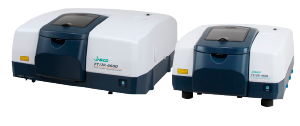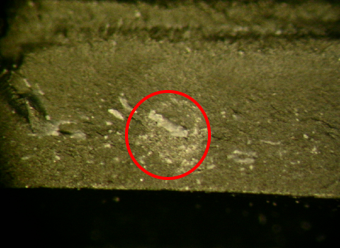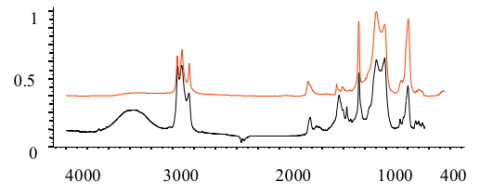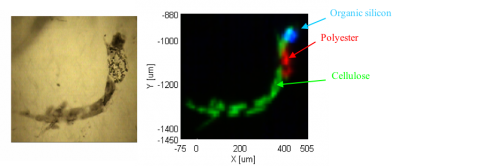Analysis of Foreign Compounds using IMV-4000
April 25, 2024
Introduction

The IMV-4000 is an FTIR microscope with a 16-element linear array MCT detector. The IMV-4000 linear array MCT detector combined with a high-speed scanning FTIR, precision auto-stage, and parallel data processing enables mapping measurement of up to 9,600 points per minute. Measurement can be made up to 100 times faster than conventional mapping measurements made using a single element detector.
When using a single-element detector to measure samples in which there are multiple components, it may be difficult to identify a single component in an observed image because the components may be non-uniformly distributed and it is likely that multiple components will be measured simultaneously. In the case where a spectrum is an aggregate of several components, and when qualitative analysis is made using a library search program it can be difficult to accurately separate and analyze each component because the database of spectral libraries are usually comprised of single components. It is possible to perform mapping measurements and separate multiple foreign substances using a single-element detector with a narrow aperture and long accumulations, but it can take an extremely long time to identify all the components.
A linear array FTIR microscope can quickly perform wide area mapping measurements for the characterization of biological samples, multilayer films and others types of samples, and it can efficiently separate multiple components that are closely spatially distributed by using a very small measurement aperture. In this application note, an IMV-4000 was used to perform IR mapping of foreign substances contaminating a resin sample. After mapping measurement was performed, a library search program was used to analyze the characteristic spectra obtained in the map. Three components were identified: cellulose, polyester, and organic silicon. JASCO’s mapping analysis program was used to create image maps of the measured area based on the height or area of the peaks in the spectra, as well as simultaneously visualizing multiple image maps in an RGB display; this function was used to confirm the distribution of the three components by overlaying a 3D-colored view of each key band.
IMV-4000 can perform wideband mapping measurements in an extremely powerful way to characterize biological samples, multilayer films among others types of samples, because it can efficiently separate multiple components that are spatially distributed by using its minute aperture.
In this application note, the IMV-4000 was used to perform IR mapping of foreign substances contained within resin. After microscopic mapping measurement was performed, a library search program was used to analyze the characteristic spectra obtained from each region. There were three components identified: cellulose, polyester, and organic silicon. JASCO’s mapping analysis program was able to create image maps of the measurement area based on the height and area of peaks, as well as instantaneously visualize multiple image maps in RGB display; this function was used to confirm the distribution state of three components by overlaying a 3D-colored view of each key band.
Experimental
The foreign substances contained within the resin were extracted, a plate was made using KBr, and microscopic measurement was performed using transmission measurement. The foreign substances were measured and identified based on the obtained spectra.

Keywords
030-MT-0194, MCT detector, linear array, multiple components and IMV-4000
Results
Spectra were measured of three different foreign compounds found in the sample and a KnowItAll® search was made. The library search confirmed the identities of each of the foreign compounds contained in the sample.


The peaks specific to each component in the above spectra are classified by color. Figure 4 is a distribution map of the specific peaks and an observed image of foreign compounds.

Green: Cellulose (3344 cm-1) Red: Polyester (1261 cm-1) Blue: Organic silicon (1800 cm-1)
Featured Products:

Analysis of Foreign Compounds using IMV-4000
Introduction

The IMV-4000 is an FTIR microscope with a 16-element linear array MCT detector. The IMV-4000 linear array MCT detector combined with a high-speed scanning FTIR, precision auto-stage, and parallel data processing enables mapping measurement of up to 9,600 points per minute. Measurement can be made up to 100 times faster than conventional mapping measurements made using a single element detector.
When using a single-element detector to measure samples in which there are multiple components, it may be difficult to identify a single component in an observed image because the components may be non-uniformly distributed and it is likely that multiple components will be measured simultaneously. In the case where a spectrum is an aggregate of several components, and when qualitative analysis is made using a library search program it can be difficult to accurately separate and analyze each component because the database of spectral libraries are usually comprised of single components. It is possible to perform mapping measurements and separate multiple foreign substances using a single-element detector with a narrow aperture and long accumulations, but it can take an extremely long time to identify all the components.
A linear array FTIR microscope can quickly perform wide area mapping measurements for the characterization of biological samples, multilayer films and others types of samples, and it can efficiently separate multiple components that are closely spatially distributed by using a very small measurement aperture. In this application note, an IMV-4000 was used to perform IR mapping of foreign substances contaminating a resin sample. After mapping measurement was performed, a library search program was used to analyze the characteristic spectra obtained in the map. Three components were identified: cellulose, polyester, and organic silicon. JASCO’s mapping analysis program was used to create image maps of the measured area based on the height or area of the peaks in the spectra, as well as simultaneously visualizing multiple image maps in an RGB display; this function was used to confirm the distribution of the three components by overlaying a 3D-colored view of each key band.
IMV-4000 can perform wideband mapping measurements in an extremely powerful way to characterize biological samples, multilayer films among others types of samples, because it can efficiently separate multiple components that are spatially distributed by using its minute aperture.
In this application note, the IMV-4000 was used to perform IR mapping of foreign substances contained within resin. After microscopic mapping measurement was performed, a library search program was used to analyze the characteristic spectra obtained from each region. There were three components identified: cellulose, polyester, and organic silicon. JASCO’s mapping analysis program was able to create image maps of the measurement area based on the height and area of peaks, as well as instantaneously visualize multiple image maps in RGB display; this function was used to confirm the distribution state of three components by overlaying a 3D-colored view of each key band.
Experimental
The foreign substances contained within the resin were extracted, a plate was made using KBr, and microscopic measurement was performed using transmission measurement. The foreign substances were measured and identified based on the obtained spectra.

Results
Spectra were measured of three different foreign compounds found in the sample and a KnowItAll® search was made. The library search confirmed the identities of each of the foreign compounds contained in the sample.


The peaks specific to each component in the above spectra are classified by color. Figure 4 is a distribution map of the specific peaks and an observed image of foreign compounds.

Green: Cellulose (3344 cm-1) Red: Polyester (1261 cm-1) Blue: Organic silicon (1800 cm-1)
Keywords
030-MT-0194, MCT detector, linear array, multiple components and IMV-4000

 Download This Application
Download This Application
